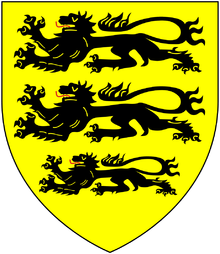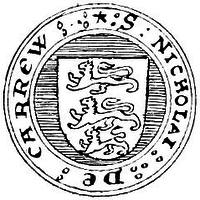Manor of Moulsford
Moulsford is an historic manor in the county of Berkshire in England. In the Middle Ages until 1497 the manor of Moulsford was a principal seat of the prominent Carew family,[1] also seated at Carew Castle in Pembrokeshire and later at Mohuns Ottery in Devon.
Descent of the manor
Norman Conquest
The manor of Moulsford is not listed in the Domesday Book of 1086 and is believed at that time to have been included within the royal manor of Cholsey.
Carew

The descent of the manor in the Carew family was as follows:
Gerald de Windsor (c.1075-1135)
Gerald de Windsor (c.1075-1135)(alias Gerald FitzWalter, Gerald son of Walter), Constable of Pembroke Castle in the Kingdom of Deheubarth, Wales, who received Moulsford by grant of King Henry I (1100-1135).[3] He was the husband of Nesta ferch Rhys (c.1085, d.pre-1136), the mistress of King Henry I and the only legitimate daughter of Rhys ap Tewdwr (before 1065 – 1093), Prince of Wales,[4] the last King of Deheubarth[3] in Wales, by his wife Gwladys ferch Rhiwallon ap Cynfyn of Powys. The Carew's seat of Carew Castle, Pembrokeshire, was in the Kingdom of Deheubarth. He was the second son of Walter FitzOther, Constable of Windsor Castle in Berkshire, a principal royal residence, by his wife Gladys ap Conwyn, daughter of Rywallon ap Conwym, Prince of North Wales. As the Fitz prefix to his surname suggests, Walter was the son of Otheus, an Anglo-Saxon who had been Constable of Windsor Castle during the reign of King Edward the Confessor (1042-1066).[5]
William FitzGerald de Pembroke (d.circa 1174)
William FitzGerald de Pembroke (d.circa 1174), son and heir.[3]
Raymond FitzGerald
Raymond FitzGerald le Gros ("The Fat"), eldest son and heir, who received seizin of his father's lands. He was a knight and a distinguished commander in the military force which invaded Ireland in 1170. He married Basile, sister of Gilbert de Clare, 1st Earl of Pembroke (1100–1147) "Strongbow", but died without progeny.[3]
Odo FitzGerald de Pembroke
Odo FitzGerald de Pembroke, younger brother and heir,[3] who adopted the surname Carrio,[4] apparently in reference to his principal seat of Carew Castle, in the Welsh Kingdom of Deheubarth, and was thus the first of the Carew family. In 1194 he disputed the claim of Geoffrey de Cholsey to land in Moulsford, possibly the manor itself.
William FitzOdo / William de Carrio
William FitzOdo (alias William de Carrio),[3] eldest son and heir. In 1195 he settled his father's dispute with the de Cholsey family by payment of a fine to the royal treasury. However, in 1207 he again paid a fine, of 40 ounces of gold, not to be impleaded by Geoffrey de Cholsey, and it was made known that King John wished William de Carrio "to remain in peace thereof".[3] In 1212 he received from King John a confirmation of the grant by King Henry I to his great-grandfather Gerald de Windsor (fl.1100/35).[3]
Nicholas de Carew (d.circa 1228)
Nicholas de Carew (d.circa 1228), son and heir.[3]
William de Carew
William de Carew, son and heir, a minor at his father's death. He became a ward of King Henry III (1216-1272). The wardship of the manor of Moulsford was granted successively to John Marshall, and from July 1228 to Bertram de Crioil, Constable of Dover Castle. William de Carew appears to have held an estate in County Waterford from the king by serjeanty in 1277.[3]
Nicholas Carew (d.circa 1286)
Nicholas Carew (d.circa 1286), son and heir, who married Avice Tute,[3] daughter and heiress of Richard Tute (alias Tuitt) of Marston in County Westmeath in Ireland.[6] He went to Ireland in 1284 but had returned to England by the time of his death.

Nicholas Carew (died 1311)
Nicholas Carew (died 1311), son and heir, who in 1300–1 was summoned to Parliament by writ of King Edward I (1272-1307) as Dominus de Moulsford ("lord of the manor of Moulsford") by which he is deemed to have become Baron Carew.[7] As Nic(olae)us de Carru, D(omi)n(u)s de Mulesford ("Nicholas de Carew, lord of the manor of Moulsford") he was one of 103 signatories of the Barons' Letter of 1301 addressed to Pope Boniface VIII as a repudiation of his claim of feudal overlordship of Scotland and as a defence of the rights of King King Edward I of England as overlord of that kingdom.
John Carew (d.1324)
John Carew (d.1324), son and heir, "lord of Carew and Moulesford"[8] who received livery of Moulsford after his father's death in 1311, although in 1316 the estate was in the custody of John Wogan, Justiciar of Ireland.[9] He married twice:
- Firstly to Elinor de Mohun, daughter and heiress of Sir William de Mohun of Mohuns Ottery[10] in the parish of Luppit, Devon, by whom he had a son Nicholas Carew (died 1323) who pre-deceased his father, having married Elinor Talbot, daughter of Richard Lord Talbot,(sic, Vivian, 1895) (should be Sir Richard Talbot, who signed and sealed the Barons' Letter, 1301 and held the manor of Eccleswall in Herefordshire in right of his wife Sarah, sister of William de Beauchamp, 9th Earl of Warwick) but died childless.[11] Sir William de Mohun of Mohuns Ottery was a younger son of Reginald de Mohun (1206–1258), feudal baron of Dunster (son), by his second wife Isabel de Ferrers, widow of Gilbert Basset (died 1241)[12] and daughter of William de Ferrers, 5th Earl of Derby (1193–1254) by his wife Sibyl Marshal, a daughter and co-heiress of William Marshal, 1st Earl of Pembroke (1146/7-1219).[13] Reginald de Mohun gave the manor of Ottery to his younger son Sir William Mohun.[14]
- Secondly John Carew married Joan Talbot, daughter of Sir Gilbert Talbot, by whom he had a son John Carew (died 1363), the heir of his half-brother Nicholas Carew (died 1323),[15] from whom he inherited Mohuns Ottery, an important future seat of the Carew family. Joan Talbot survived him and remarried to John Dartmouth (alias Tuckett).[16]
Thomas Carew (d.1331)
Thomas Carew (d.1331), younger brother, stated by the Berkshire jury in the inquisition post mortem of John Carew (d.1324) to be the next heir, although another inquisition post mortem in another county stated his heir to be John's son by his second marriage, namely John Carew (died 1363).[17] However, the jury's decision and the resulting order of the king's escheator was apparently ignored by the family as the manor was seized by a certain "Master William Carew"[18] (possibly William Carew (d.1359),[19] Thomas's younger brother), and later during the night on 6 May 1325, was seized by Joan Talbot (widow of John Carew) who had received as her dower the usual widow's 1/3 of her husband's manor,[20] and by her son John Carew (died 1363). Joan was later a servant of Queen Philippa of Hainault (1314-1369),[21] wife of King Edward III. A share in the manor was also held as dower by Elinor Talbot, widow of Nicholas Carew (died 1323).[22] In 1331 Thomas Carew received licence to enfeoff "Master William Carew", probably in trust for his nephew John Carew (died 1363).[23]
Sir John Carew (died 1362/3)
Sir John Carew (died 1363), Justiciar of Ireland. He married twice:
- Firstly to Margaret de Mohun, a daughter of John de Mohun, feudal baron of Dunster,[24] by whom he had progeny Sir Leonard Carew (d.1369), eldest son and heir; John Carew, "slain in the Irish wars", who predeceased his father without progeny, having married Agnes Martin, a daughter of Sir William Martin;[25] also Nicholas, William and Edward.
- Secondly he married Elizabeth Corbet.[26]
He died on Whit Monday, 1362[27]
Sir Leonard Carew (d.1369)
Sir Leonard Carew (d.1369), eldest son and heir, who married Alice FitzAlan, a daughter of Sir Edmund FitzAlan de Arundell, a younger brother of Richard FitzAlan, 13th Earl of Arundell.[28] He received seisin of Moulesford in 1364.[29] He died on 9 October 1369, leaving an infant son Thomas Carew (1361-1430).
Thomas Carew (1361-1430)
Thomas Carew (1361-1430), son, a minor at his father's death, when Moulsford was in the wardship of his father's "next friend", evidently Nicholas Carew of Purley in Theale hundred, who was granted free warren at Moulsford in 1373.[30] Thomas married Elizabeth Bonville (d.1451), who survived him, a daughter of Sir William Bonville of Shute in Devon. He was in possession of Moulsfordin 1401,[31] and settled lands on his wife Elizabeth on 8 April 1410.[32]
Nicholas Carew
Nicholas Carew, son, of Moulsford and of Mohuns Ottery in Devon, who married Joan Courtenay, a daughter of Sir Hugh Courtenay (c.1358-1425), of Haccombe and of Boconnoc in Cornwall, who had married as his second wife Phillipa Archdekne, heiress of Haccombe. Sir Hugh Courtenay was a Member of Parliament and Sheriff of Devon, a grandson of Hugh de Courtenay, 2nd/10th Earl of Devon (1303–1377), and was the younger brother of Edward de Courtenay, 3rd/11th Earl of Devon (1357–1419), "The Blind Earl", and by his third wife was the grandfather of Edward Courtenay, 1st Earl of Devon (d.1509), KG, created Earl of Devon in 1485 by King Henry VII. His marriage to Phillipa Archdekne was without male progeny, but did produce a daughter Joane Courtenay (born 1411), the wife of Nicholas III Carew of Mohuns Ottery in Devon, and the eventual sole-heiress of her mother Phillipa Archdekne, from whom she inherited 16 manors including Haccombe, which she divided amongst her younger Carew sons.[33] In 1437 Nicholas Carew, together with his widowed mother Elizabeth Bonville (d.1451), re-settled the lands onto his mother with remainder to himself and his wife Joan Courtenay (born 1411).[34]
Thomas Carew (d.1446)
Thomas Carew (d.1446)[35] of Mohuns Ottery, eldest son of Nicholas Carew and Joan Courtenay.
Nicholas Carew (1424-1471)
Nicholas Carew (1424-1471),[36] of Mohuns Ottery, eldest son, who transferred Moulsford to Joan Denham, widow, and others, probably in trust for his son Sir Edmund Carew (1465-1513).[37]
Sir Edmund Carew (1465-1513)
Sir Edmund Carew (1465-1513)[38] of Mohuns Ottery, eldest son, who in 1497 sold Moulsford and other Berkshire estates to Bartholomew Reed, a Citizen and goldsmith of the City of London.[39]
Sources
- Victoria County History, Berkshire, Volume 3, ed. P H Ditchfield and William Page, London, 1923, pp.504-7, Parishes: Moulsford
- Vivian, Lt.Col. J.L., (Ed.) The Visitations of the County of Devon: Comprising the Heralds' Visitations of 1531, 1564 & 1620, Exeter, 1895, p.133, pedigree of Carew
References
- Royal Berkshire History: Moulsford Manor
- Debrett's Peerage, 1968, Carew Baronets, p.155; Baron Carew p.216; These were the arms shown on the seal of Nic(olae)us de Carru (c.1255–1311), appended to the Barons' Letter, 1301 and blazoned in the 1301 Caerlaverock Roll of Arms
- VCH
- Vivian, p.133
- Vivian, Lt.Col. J.L., (Ed.) The Visitations of the County of Devon: Comprising the Heralds' Visitations of 1531, 1564 & 1620, Exeter, 1895, p.133, pedigree of Carew
- Vivian, p.134
- VCH, note 44, quoting: Parliamentary Writs (Record Commission), Vol.I, p.104
- Vivian, p.134
- VCH
- Risdon, Tristram (d.1640), Survey of Devon, 1811 edition, London, 1811, with 1810 Additions, p.38
- Pole, p.333
- Pole, p.128
- Sanders, I.J. English Baronies: A Study of their Origin and Descent 1086-1327, Oxford, 1960, p.114
- Pole, p.128
- Pole, p.333
- Vivian, p.134
- VCH
- VCH
- Vivian, p.134
- VCH
- VCH
- VCH
- VCH
- Vivian, Lt.Col. J.L., (Ed.) The Visitations of the County of Devon: Comprising the Heralds' Visitations of 1531, 1564 & 1620, Exeter, 1895, p.134
- Vivian, p.134
- Vivian, p.134
- VCH
- Vivian, p.134
- VCH
- VCH
- VCH
- VCH
- Risdon, p.140
- Date of birth per Vivian, p.245
- VCH
- VCH
- VCH
- VCH
- VCH